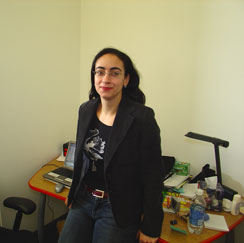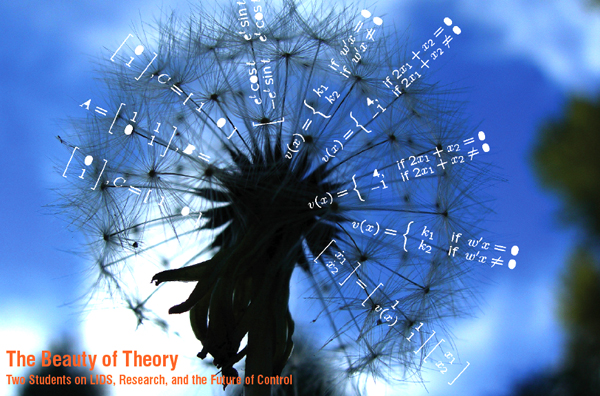What brings students to LIDS’ unique intellectual environment? Keith Santarelli and Danielle Tarraf, like most of their fellow PhD candidates, didn’t start their graduate student careers at MIT with a well-defined path of study. As Keith points out, at first most students will have identified a general research interest, such as “circuits vs. optics,” but won’t yet know their specialized area. Danielle adds, “This is one of the strong points of MIT. You have the avenues to explore to find your match.” That exploration brought both Keith and Danielle, independently, to the control systems group at LIDS.
For Keith, like Danielle, initial work in more applied engineering problems (circuit design, in his case, machine design and thermodynamics, in hers) led to exposure to higher-level theory, at which point they were both hooked. When asked what drew him to the field, Keith replies, “theory is much more beautiful than the real world.” He goes on to explain that, for him, “the more interesting stuff is figuring out how things work, or how things should be. How you can take existing ideas and combine them to get a new, interesting idea.” Yet because of this theoretical focus, he jokes, “I don’t even tell most people that I’m an engineer anymore, because they don’t really associate what I do with actual engineering.”
The commitment to the mathematical tools and ideas behind technological advances is part of what makes LIDS exceptional, and draws great minds to the lab. While the theoretical nature of the research may be difficult for the rest of us to grasp, it carries with it eminently practical implications. When put in simple terms, it becomes clear just how influential a field like control theory, for example, has been for modern technology. Keith and Danielle separately offered a similar, basic overview of the field by using the example of a car. The system (the car) is manipulated (speeding up or slowing down) according to feedback (looking at the speedometer). Control theory automates that process, and voila, cruise control. Modern control theory is much more complex than this example, of course, as systems from cars to airplanes to networks become bigger and more complicated. Both Keith and Danielle focus on coming up with new ideas, algorithms, and models to address that growing complexity. They offered LIDS-All some of their time in order to explain this current research, what brought them to it, and why they’ve discovered their true passion at LIDS.

Keith Santarelli is an easygoing Massachusetts native who has been at MIT since his undergraduate days. He will finish his PhD next year at LIDS, and laughs and raises his eyebrows when he says, “it’s been almost eleven years at MIT.” He was an electrical engineering major as an undergrad, working largely at the Draper Laboratory, where he continued to do work as a Master’s student. At Draper, Keith focused on circuit design, but took an introductory course in control theory taught by Professor Munther Dahleh of LIDS. “It was when I was taking that class that I really started to become interested in control,” Keith explains. As he was finishing up his M.Eng., inspired in part by that course, he realized he liked the more theoretical work and came to LIDS to pursue it.
Keith’s work is in the area of hybrid systems, at the forefront of his field and a “hot topic.” Hybrid systems incorporate elements of two distinct, well-known types of systems in control theory: continuous and discrete. To better understand the difference—and why combining the two approaches is so revolutionary—let’s turn to the world of circuits, an area Keith focuses on. Analog circuits are continuous, or characterized by processing “as a whole,” while digital circuits are discrete, and process information by “chopping up” time and amplitude. A digital sound recording, for example, stores a recorded voice as a series of numbers. These numbers can then be read by a CD, and the original sound is closely reproduced on your stereo. An analog sound recording, on the other hand, uses a waveform to represent the vibrations of the voice. That waveform can be stored on a record and reproduced as the needle moves continuously across it.
Even in this simple case, one can see that using either method exclusively isn’t ideal. In recent years digital sound has become popular because it’s clear and easy to fabricate, yet many argue that because digital recordings break up and reassemble the sound, the quality isn’t as good. Analog recordings, however, often include a great deal of outside noise because the waveform does not distinguish well between intended and “extra” sound. The gap between analog and digital extends to a much wider world of electronics and other applications. Keith’s research “is trying to figure out a way to combine analog and digital systems to take the good things from each and try to get rid of their detrimental effects.” He’s working to create concepts that can eventually be used to build more efficient circuits, to name one example. Though the average consumer may not understand the impact of such research, it means a great deal at the design level. Circuits are the building blocks of all electronics, and when they are more efficient, household goods and systems become better across the board. Keith has lately been collaborating with Professor Rahul Sarpeshkar in RLE about some of these potential applications.
Keith has found a real home at LIDS, and not only academically. He jokes that “free lunch every Friday”—referring to the student socials—is his favorite part about being a LIDS student. He is quick to add that the friendly environment is a hallmark of the lab. “I know a lot of students who work for different professors. We…are social on a daily basis. I think that that’s actually very important…[it] makes for a good support structure.” If something goes wrong or isn’t working, there’s always someone with whom to either commiserate or consult. Keith goes on to note that the LIDS community atmosphere is unique and, in a certain sense, just as vital as academics in the life of a student. He speculates that many prospective grad students don’t look into “the background dynamics of a lab,” which he says are crucial to understanding how you’ll fare as a student there.
At this point, Keith isn’t sure whether he’ll pursue an academic faculty position post-graduation, or perhaps join industry or a national research lab. He summarizes his options by noting, “Academia is great—you can theorize all day long—[but it’s] a long and arduous track. At the same time, the academic environment is very flexible, and I really like teaching…that’s something I would miss.” The decision approaches, as Keith plans to graduate within the year. Whatever he chooses, LIDS wishes him the best of luck.

Danielle Tarraf also found her passion in control and systems theory, after starting out in mainstream mechanical engineering and testing the waters elsewhere until she found her niche. Straightforward and friendly, Danielle came to MIT from Beirut, Lebanon, where she enjoyed math and science from a young age. Her parents encouraged her to develop these interests; she recounts that “ever since I was a kid they would say, ‘you’re going to grow up and be an engineer,’ especially my dad.” The relatively small number of women in her field never deterred her, and though she was one of two women in her undergraduate mechanical engineering class of forty, she says “it didn’t strike me as odd.” Encouraged by excellent mentors and a passion for engineering, she applied to MIT, and when her dream of attending became a reality, she jumped at the chance to explore her varied interests.
Her research, like Keith’s, is at the cutting edge of systems and control theory, particularly as it relates to computer science, algorithms and computation. Danielle also deals with “hybrid systems,” which are complex due to interacting continuous and discrete dynamics. She works to develop paradigms and computational tools to systematically and efficiently tackle these systems. Control theory relies on models of systems, that is, mathematical descriptions of how the systems behave; typically, these models are based on some understanding of the underlying physics. Danielle’s work explores the use of finite state machines, which are discrete models (traditionally used in computer science), to describe hybrid systems for controller design. She emphasizes that providing “performance guarantees” is an important goal of her work.
She uses a basic, “toy problem” example of temperature control to illustrate her approach. Suppose you want to regulate the temperature of a room based on crude measurements, but you can’t gradually adjust it; you can only flip the switch. Her research would tell you when to turn the heat on or off, in order to remain within a range of the desired temperature. Of course, this simple control design task can be accomplished through trial and error – experimenting with different algorithms until you find one that works. However, this “ad-hoc” approach is far from ideal when dealing with more complex systems: cars, for example, now consist of several physical subsystems interacting with computers. “These days,” Danielle points out, “the tendency is for systems to get…more complicated, and the only way you’ll be able to deal with them is to have a systematic framework.” She speculates that her work will be applicable in a wide range of areas, from data networks to flexible manufacturing systems or even cellular computation.
While control theory is her main interest area, Danielle likes learning about other fields and frequently attends talks that don’t concern her specific research. The best aspect of the weekly LIDS colloquia, she notes, is the chance to learn about a particular topic from a leading expert, and decide if it’s an area for further exploration. In fact, she has become interested in research related to error-correcting codes and data networks, which she has “filed away in my mind as something I’d like to explore later.” Danielle recently acted as a student organizer of the colloquia, and enjoyed having input into which speakers would visit. Overall, she appreciates the “different levels of interaction” within LIDS, and an intellectual culture of innovation and cooperation where “it’s very easy to talk to people in different areas.”
Though Danielle does not have concrete future plans, she knows her passion lies in the research and teaching opportunities of a university. When she first started her PhD she thought of pursuing a career in industry, but her time at LIDS has inspired her to pursue a position in academia. “It’s the right environment,” she concludes.




